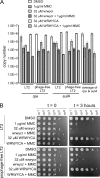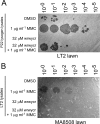Peptide wrwycr inhibits the excision of several prophages and traps holliday junctions inside bacteria
- PMID: 19181810
- PMCID: PMC2655501
- DOI: 10.1128/JB.01559-08
Peptide wrwycr inhibits the excision of several prophages and traps holliday junctions inside bacteria
Abstract
Peptide inhibitors of phage lambda site-specific recombination were previously isolated by screening synthetic combinatorial peptide libraries. These inhibitors cause the accumulation of complexes between the recombinase and the Holliday junction intermediate of several highly divergent tyrosine recombinases. Peptide WRWYCR and its d-amino acid derivative bind to the center of protein-free junctions and prevent their resolution either by site-specific recombinases or by junction resolvases or helicases. With lesser affinity, the peptides also bind to branched DNA molecules that mimic replication forks. The peptides are bactericidal to both gram-positive and gram-negative bacteria, presumably because they can interfere with DNA repair and with chromosome dimer resolution by the XerC and XerD tyrosine recombinases. In order to test the correspondence between their mechanism in vivo and in vitro, we have tested and shown peptide wrwycr's ability to inhibit the excision of several prophages (lambda, P22, Gifsy-1, Gifsy-2, Fels-1, Fels-2) and to trap Holliday junction intermediates of phage lambda site-specific recombination in vivo. In addition, we found that the peptide inhibits replication of the Salmonella prophage Fels-1 while integrated in the chromosome. These findings further support the proposed mechanistic basis for the antimicrobial activity of the peptide and its use as a tool to dissect strand exchange-dependent DNA repair within cells.
Figures



Similar articles
-
Mechanism of inhibition of site-specific recombination by the Holliday junction-trapping peptide WKHYNY: insights into phage lambda integrase-mediated strand exchange.J Mol Biol. 2003 Mar 21;327(2):413-29. doi: 10.1016/s0022-2836(03)00058-5. J Mol Biol. 2003. PMID: 12628247
-
An antimicrobial peptide that targets DNA repair intermediates in vitro inhibits Salmonella growth within murine macrophages.Antimicrob Agents Chemother. 2010 May;54(5):1888-99. doi: 10.1128/AAC.01610-09. Epub 2010 Feb 22. Antimicrob Agents Chemother. 2010. PMID: 20176906 Free PMC article.
-
Potent antimicrobial small molecules screened as inhibitors of tyrosine recombinases and Holliday junction-resolving enzymes.Mol Divers. 2011 Nov;15(4):989-1005. doi: 10.1007/s11030-011-9333-2. Epub 2011 Sep 22. Mol Divers. 2011. PMID: 21938393
-
The impact of prophages on bacterial chromosomes.Mol Microbiol. 2004 Jul;53(1):9-18. doi: 10.1111/j.1365-2958.2004.04113.x. Mol Microbiol. 2004. PMID: 15225299 Review.
-
Homologous recombination in Archaea: new Holliday junction helicases.Biochem Soc Trans. 2003 Jun;31(Pt 3):703-5. doi: 10.1042/bst0310703. Biochem Soc Trans. 2003. PMID: 12773187 Review.
Cited by
-
Potentiation of Antibiotics by a Novel Antimicrobial Peptide against Shiga Toxin Producing E. coli O157:H7.Sci Rep. 2020 Jun 22;10(1):10029. doi: 10.1038/s41598-020-66571-z. Sci Rep. 2020. PMID: 32572054 Free PMC article.
-
Antimicrobial metallopeptides with broad nuclease and ribonuclease activity.Chem Commun (Camb). 2013 Mar 14;49(21):2118-20. doi: 10.1039/c3cc38977d. Epub 2013 Feb 5. Chem Commun (Camb). 2013. PMID: 23380915 Free PMC article.
-
Analysis of RuvABC and RecG involvement in the escherichia coli response to the covalent topoisomerase-DNA complex.J Bacteriol. 2010 Sep;192(17):4445-51. doi: 10.1128/JB.00350-10. Epub 2010 Jul 2. J Bacteriol. 2010. PMID: 20601468 Free PMC article.
-
Tumor cell death mediated by peptides that recognize branched intermediates of DNA replication and repair.PLoS One. 2013 Nov 14;8(11):e78751. doi: 10.1371/journal.pone.0078751. eCollection 2013. PLoS One. 2013. PMID: 24244353 Free PMC article.
-
Similarities between exogenously- and endogenously-induced envelope stress: the effects of a new antibacterial molecule, TPI1609-10.PLoS One. 2012;7(10):e44896. doi: 10.1371/journal.pone.0044896. Epub 2012 Oct 11. PLoS One. 2012. PMID: 23071502 Free PMC article.
References
-
- Abremski, K., and S. Gottesman. 1982. Purification of the bacteriophage lambda xis gene product required for lambda excisive recombination. J. Biol. Chem. 2579658-9662. - PubMed
-
- Azaro, M. A., and A. Landy. 2002. λ Integrase and the λ Int family, p. 118-148. In N. L. Craig, R. Craigie, M. Gellert, and A. M. Lambowitz (ed.), Mobile DNA II. ASM Press, Washington, DC.
-
- Becerril, C., M. Ferrero, F. Sanz, and A. Castano. 1999. Detection of mitomycin C-induced genetic damage in fish cells by use of RAPD. Mutagenesis 14449-456. - PubMed
-
- Boldt, J. L., C. Pinilla, and A. M. Segall. 2004. Reversible inhibitors of lambda integrase-mediated recombination efficiently trap Holliday junction intermediates and form the basis of a novel assay for junction resolution. J. Biol. Chem. 2793472-3483. - PubMed
-
- Brumby, A. M., I. Lamont, I. B. Dodd, and J. B. Egan. 1996. Defining the SOS operon of coliphage 186. Virology 219105-114. - PubMed
Publication types
MeSH terms
Substances
Grants and funding
LinkOut - more resources
Full Text Sources

